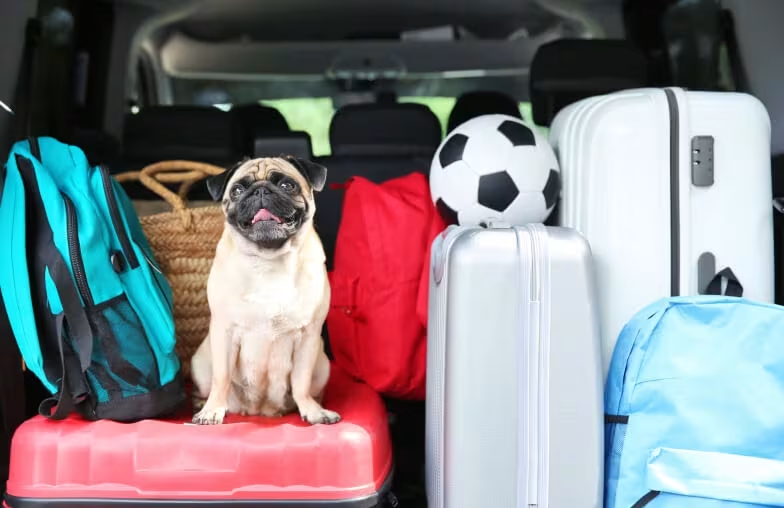Are you — like us — obsessed with canine TikTok star Boomer, the mega-fluffy samoyed "landcloud" whose owners (aka Devoted Pet Lovers) pop him and his floof into a backpack, then take him everywhere they go?
If only travelling with pets was always that simple — and if only every dog or cat loved a good knapsack ride.
That said, whether or not your beloved fur baby fits into a piece of luggage isn't really the issue. Travelling with pets is more about making them (and you) feel safe, happy, and entertained. The priceless pics and social media moments are just a bonus.
Read on for expert advice on travelling across Canada with your pet this summer (and beyond)!
The ultimate pet packing list for long trips
Janet Bredin has been shelter manager for the North Bay and District Humane Society for more than a decade. As part of her role there, she is responsible for transporting rescue dogs and cats across Canada on the journey to their forever homes. One of her most memorable: she travelled with more than 80 dogs.
Bredin is a professional when it comes to travelling with animals, especially when it comes to pre-trip prep and packing.
Bredin references a huge rescue operation the Humane Society completed, in partnership with a Manitoban organization, as a great template for anyone transporting an individual animal — just on a smaller scale.
"When we do these transfers, we always think about the 'what if?' So we'll go with basic bandaging, we'll go with extra padding and kennels, we'll go with different types of foods, and we'll go with basic medical care. If we do a large dog pickup or a large cat pickup, I'll go with basic medications: pain medications, antibiotics, flea treatments — emergency care that we can provide on-site to relieve any immediate distress."
How does this translate to the at-home pet parent? If you're headed to the cabin for a week, for example, Bredin says to consider any 'what ifs' that might be specific to your pet and pack accordingly. That might include bringing extra medication along in case your trip is unexpectedly extended if your pet has an underlying medical concern.
Bredin recommends packing the following essential items in your long-haul-travel-with-pets kit:
More food than you think is needed
More treats than you think are required
Litter if you're travelling with a cat
It's also smart to pack a DIY pet passport that includes:
Updated vaccination records
Microchip number and the contact number of the tracking company
Essential medical and vet information
While you're on the road, Bredin advises making your travel companion as comfortable as possible. “There are calming sprays and pheromones that you can bring for the animals to alleviate distress. Obviously give them food, water, bedding, so you cover off their basic needs,” she says.
"For both cats and dogs we'll bring treats and toys. The toys give them something to do. Engagement is really important for them, even if it's just limited engagement. If they're in a very small area, they still have the opportunity to bat around a toy if they need to."
Travelling by planes and trains
If you don't have access to a car and need to travel across Canada or even to the U.S., (whether that's for vacation, work, or relocation), travelling with your pet can get a bit more complicated. Air travel especially requires a lot of boxes to be checked, and rules can differ between one airline and another.
The first thing to figure out is whether or not your pet can fly in the cabin along with you, or if they have to ride in cargo. This is determined by their size.
Flying with your pet inside the cabin
Your pet has to be able to fit in its carrier under the seat in front of you in a standing position. (It's advisable to check with your specific airline to see the exact under seat measurements).
With Air Canada, for example, this means you have to book a seat that has another seat in front of it. Bulkhead seats don't have that (there goes your extra leg room) and Premium Economy seats can't accommodate this option either.
You also can't book a seat for you and your pet in an emergency exit row. Finally, be aware that your pet carrier counts as your carry-on luggage, so be sure to check your suitcase. And theirs.
Flying with a larger pet inside the cargo area
If you have to cross Canada with a larger dog, they'll need to ride in the pressurized cargo area. The top priority here is to make sure you've booked a ticket within safe flying windows.
Because cargo areas aren't sufficiently regulated for very cold or very hot temperatures, certain flights have blocked off periods where pets are not permitted to travel in cargo. And during the December holiday travel rush, there are no spaces for dogs in cargo at all.
Dogs travelling in cargo must be transported in crates large enough for them to stand, turn around, and stretch out to their full length. Certain breeds like pit bulls, mastiffs, and rottweilers have to travel in special reinforced metal crates while snub-nosed dogs (and cats) are not permitted in cargo at all because of an increased risk of heat stroke and breathing issues.
If you're used to booking your travel online, prepare to pick up the phone and make a few calls when booking for a larger pet instead.
This is especially true if you're flying with a dog in tow, from Halifax to Vancouver with a stopover in Montreal, for example. You'll need to be sure there's a cargo spot available on both flights. While the airlines coordinate to make sure their human guests have seats on each leg of their journey, this isn't always the case for cargo-travelling pets.
Bringing your pet with you on a train
Ready to test out the train? Rules are a little more relaxed but size restrictions definitely still apply.
Train-riding pets under a certain size (check the VIA Rail website for exact weight and dimension specifics) can travel with you in their carriers, inside the passenger cabin — but only on certain routes.
Long-haul routes also allow larger pets to ride in the luggage carriage with no weight restrictions as long as they are in a suitably large crate that allows them to move around a little.
The crate must be locked and animals must be muzzled anytime that they are outside of the crate (think: boarding and disembarking).
VIA asks that customers coordinate with them in advance when travelling with pets.
Once onboard, travellers with pets must engage with a Service Manager who will accompany them to visit and feed larger animals throughout a long journey.
One major catch: summertime travellers with large dogs should also be aware that the luggage area is not air conditioned and therefore VIA doesn't permit large pet travel from June 1 through to September 30.
Where to go with a dog
To some travellers, holing up in a nice hotel room might be their version of the ultimate vacation. For most dogs, it won't be.
When picking a place to travel to this summer, look for destinations with fun options that allow you and your dog to get out and do things together. Dog parks, dog-friendly beaches, businesses that welcome dogs, and hotels or vacation rental properties that cater to them are important amenities for any canine-cation (especially one that involves a long car ride in order to get there).
Camping with dogs, whether in a tent or a trailer, is almost always going to be a hit with your pup.
Think: MAJOR new smells, a lake for swimming and aquatic games, as well as trails to explore.
First-time canine campers, however, are likely as unsure about campsite etiquette and safety as you were on your inaugural camping trip. Be prepared for encounters with wildlife, insects, and other hazards by having a doggie first aid kit on-hand should your BFF need immediate attention or just some light itch relief. If you are in doubt at all about an injury, visit your vet.
Do cats camp? The short answer is yes, of course they do! No matter where you're taking your travelling feline, however, security is the top concern.
All frightened animals have the potential to bolt away — it's just that cats are better at it. A secure carrier plus a leash and harness set are your best defence against an MIA cat or kitten, whether your destination is a hotel, cottage, or campsite.
Is your pet the travelling type?
Maybe the most important thing to ask yourself when you're planning a trip with your pet is “Will my pet actually enjoy this?”
Travelling can be tough on senior animals who don't get around as easily as they once did or for animals — yes, we're looking at you, cats — who are particularly devoted to their regular routine and environment.
At the other end of the scale, puppies and kittens can have a hard time being cooped up in a crate for extended periods of travel time and may express their displeasure in ways that do a serious number on your rental car.
With a new pet — even an adult one — Bredin advises that pet parents do some research on how they might manage a long trip.
“If somebody hasn't travelled with an animal before, either reach out to the adoption agency or the adopting rescue and ask if they know any travel history for that animal, the do's and the don'ts for that particular animal, and what that agency recommends,” she says.
Above all, she says, “Assume that the animal is going to be scared, that the animal is going to be stressed, and move slowly and be respectful that way.”















































